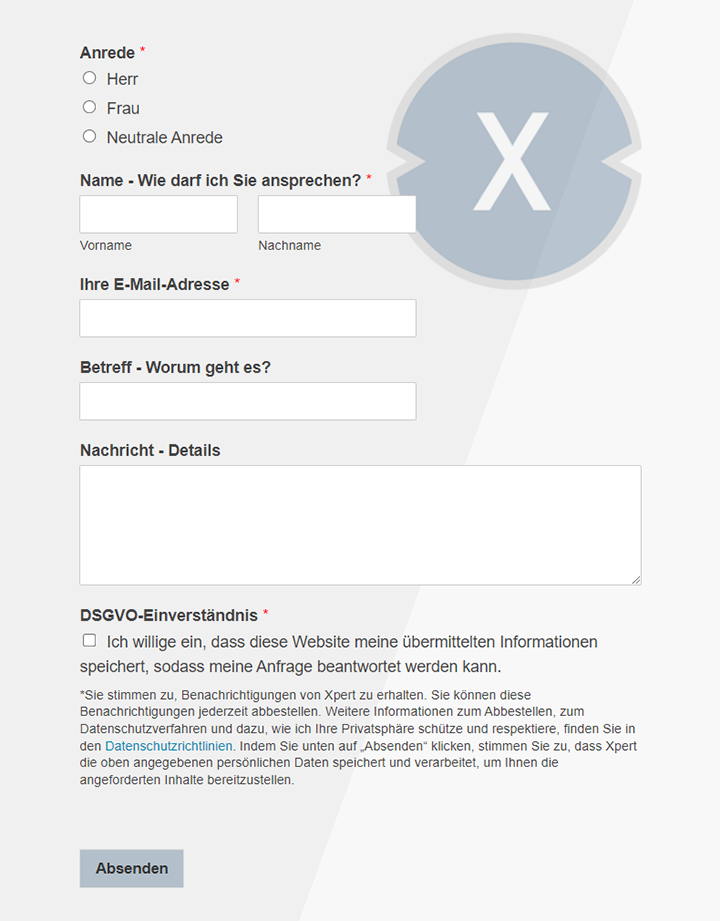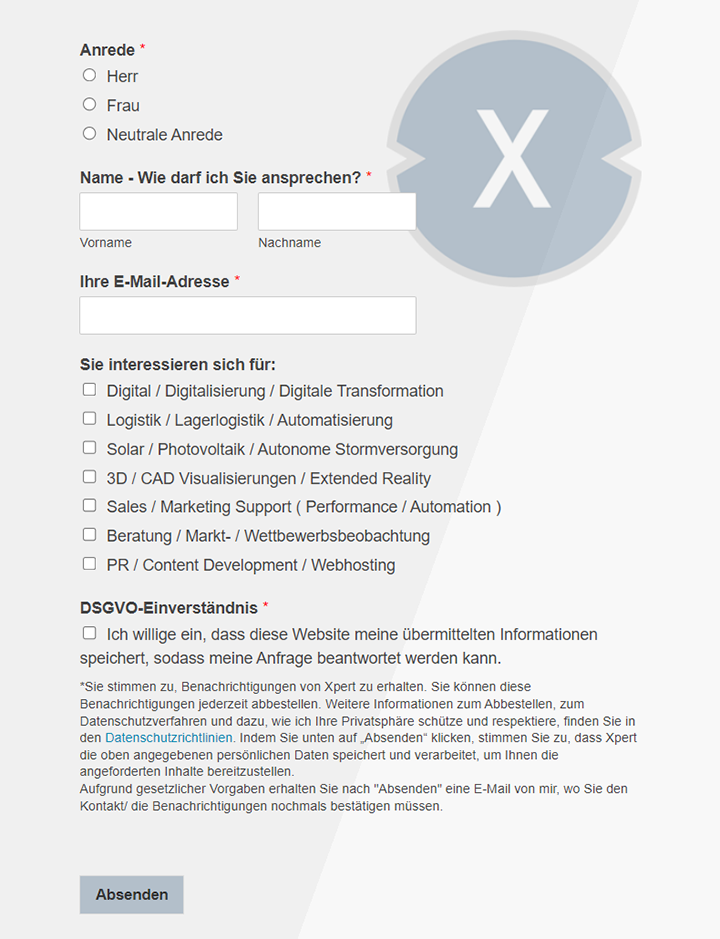German administration and bureaucracy: 835 million euros per day – Are the costs for Germany's civil servants really exploding?
Xpert pre-release
Language selection 📢
Published on: September 4, 2025 / Updated on: September 4, 2025 – Author: Konrad Wolfenstein

German administration and bureaucracy: €835 million per day – Are the costs for Germany's civil servants really exploding? – Image: Xpert.Digital
Waste of billions? Study reveals: 60,000 public sector jobs could be lost
### Germany's bloated apparatus: More and more civil servants, even though the population isn't growing – what's behind it? ### The trillion-euro burden: Why civil servant pensions threaten to overwhelm Germany's finances ###
Germany's public administration is a giant—and an expensive one at that. With daily personnel costs of €835 million and a workforce that has grown to 5.4 million, the state apparatus is increasingly the focus of critical debate. This growth seems all the more remarkable given that the population has been stagnating for years and the private sector, especially industry, is cutting jobs. The key question is: Is this growth justified or a sign of inefficiency?
While unions argue that new challenges like digitalization and all-day care are imminent, studies show enormous savings potential of up to 60,000 jobs and over three billion euros annually. The financial burden is exacerbated by a looming pension avalanche, which will burden future budgets with trillions of euros. The political debate has flared up and ranges from radical reforms of the civil service to concrete austerity plans, while Germany's staffing levels are surprisingly lean compared to other countries.
Suitable for:
- Typically German because we need a bureaucracy relief law? The current status of the economy and renewable energies such as PV
What does the German government spend on its employees every day?
The financial dimension of German public administration is impressive: According to calculations by the Federal Statistical Office, German states and municipalities spend approximately €835 million daily on their personnel. This figure includes the salary and personnel costs of all state and municipal government employees. It is important to understand that these costs are continuously rising, while the population in Germany has stagnated between 83 and 84 million for six years.
The total number of people employed in the public sector increased to around 5.4 million by mid-2024, an increase of almost 96,000. This means that almost twelve percent of all employed people in Germany work in the public sector. This development reflects a significant shift in the employment structure: While industry had around 146,000 fewer employees subject to social insurance contributions in June than in the previous year, 45,000 new jobs were created in public administration during the same period.
How has the workforce in the public sector developed?
The development of the public service over the past ten years shows significant growth at all levels of government. Between 2013 and 2023, the number of municipal employees increased by 24 percent and that of state employees by almost 12 percent. The increase at the federal level was significantly lower, at around 4 percent.
The development in certain areas is particularly noteworthy. The area of "political leadership and central administration" was significantly expanded at all levels: At the federal level, the number of employees increased by 11,000 (32 percent), at the state level by 28,000 (21 percent), and at the local level by 79,000 (27 percent). On average, the number of municipal employees per 100,000 inhabitants increased by almost 21 percent during the period under review.
Significant growth is also evident in the areas of education and childcare. The number of employees in municipal childcare facilities has more than doubled since 2009. By mid-2024, schools employed over one million people, including 354,800 employees and 693,200 civil servants. Universities, including university hospitals, recorded a staff increase of around 41 percent compared to 2009.
What are the reasons given for the increase in staff?
The unions and civil service associations view the increase in staffing as necessary, arguing that the workload is increasing. The German Civil Service Federation lists "all-day care, property taxes, the changing times, the digitization of administration, documentation requirements, and basic child benefits" as reasons for the additional staffing needs. According to a survey conducted by the Civil Service Federation in July 2025, the staffing situation is dire, and the state is short by an additional 600,000 employees.
However, this argument is being critically scrutinized. In particular, the argument that digitalization must lead to job creation is not immediately clear, as digitalization should normally enable efficiency gains and staff reductions. The "turning point" argument is also criticized as incomprehensible.
The administration certainly sees itself as being under fire. In a Germany-wide survey of over 300 public authorities, almost half of the heads of public authorities believe that the state is overwhelmed by its responsibilities and problems. At the same time, demographic change and employer attractiveness rank high on the list of the greatest challenges.
How efficiently do the different federal states work?
A recent study by the German Economic Institute (IW) compared the efficiency of public services in various German states. The results reveal significant differences between the states. Saxony-Anhalt is considered the leader in efficiency, while other states have significant savings potential.
According to calculations, North Rhine-Westphalia could eliminate 13,000 public sector jobs if the state were to operate at a similarly efficient level as Saxony-Anhalt. In Baden-Württemberg, the figure would be a good 10,000. Nationwide, according to this analysis, around 60,000 jobs could be saved.
Administrative costs per capita vary considerably between federal states. While the national average per capita administrative costs are €3,663, Mecklenburg-Western Pomerania is around twelve percent lower at €3,215. Hamburg, on the other hand, is 34 percent above the average at €4,914. These differences demonstrate that city-states are significantly more expensive to operate than the larger federal states.
Suitable for:
- Crafts are the essential element of our entire economy: bureaucracy and a lack of skilled workers hinder development
What financial savings potential exists?
Study director Martin Beznoska of the German Economic Institute concludes that the search for efficiency reserves is worthwhile. Based on the average gross annual salary in public administration in 2024, the nearly 60,000 redundant positions would represent potential savings of €3.4 billion per year for states and municipalities.
This calculation demonstrates the significant financial potential that lies in more efficient personnel planning. However, it should be noted that staff reductions are not readily possible and various legal and practical obstacles must be overcome. Furthermore, it must be ensured that the public sector's tasks can continue to be fulfilled.
The cost trend is further exacerbated by pension burdens. The federal government alone already spends over 60 billion euros annually on pensions and similar benefits. The average civil servant pension is around 3,400 euros per month, while average statutory pensions are significantly lower.
How much do civil servant pensions cost the state?
Civil service pensions represent a significant financial burden on public budgets. The public sector spends €63.4 billion annually on its 1.4 million retirees and their dependents. These costs will rise dramatically in the coming years, as approximately 1.5 million civil servants will retire in the coming years.
According to the current pension report of the Federal Ministry of the Interior, pension obligations will rise from approximately €6.8 billion in 2023 to €7.8 billion this year and even grow to €25.4 billion by 2060. A study by Professor Bernd Raffelhüschen estimates the total cost of civil service pensions by 2050 at between €1.3 and €1.4 trillion.
The differences between civil service pensions and statutory pensions are significant. In 2020, pensioners in the federal states received a gross monthly pension of €3,590 (men) and €2,970 (women). Average gross statutory pensions are much lower; even for those with over 45 years of insurance, the amounts paid are only €1,637 (men) and €1,210 (women).
🎯🎯🎯 Benefit from Xpert.Digital's extensive, fivefold expertise in a comprehensive service package | R&D, XR, PR & SEM

AI & XR 3D Rendering Machine: Fivefold expertise from Xpert.Digital in a comprehensive service package, R&D XR, PR & SEM - Image: Xpert.Digital
Xpert.Digital has in-depth knowledge of various industries. This allows us to develop tailor-made strategies that are tailored precisely to the requirements and challenges of your specific market segment. By continually analyzing market trends and following industry developments, we can act with foresight and offer innovative solutions. Through the combination of experience and knowledge, we generate added value and give our customers a decisive competitive advantage.
More about it here:
State Lottery: Why personnel costs vary so much in Germany
How do personnel costs differ between federal states?
Personnel expenditures vary considerably across the federal states, partly due to structural differences. In 2015, personnel expenditures for core and extra budgets amounted to €135.18 billion, corresponding to €1,665 per capita.
Among the non-urban states, Saarland has the highest per capita personnel expenditure at €1,820 per capita, while Brandenburg has the lowest at €1,306 per capita. In general, it can be observed that the eastern German non-urban states have lower per capita personnel expenditure than the western German states. A key reason for this is the significantly lower pension benefits, as pension entitlements in the eastern German states only arose after reunification.
Among the city-states, Hamburg has the highest personnel expenses at €3,184 per capita, followed by Bremen at €2,974 and Berlin at €2,687 per capita. These higher costs are explained by the fact that city-states must also perform all municipal functions in addition to their state-level responsibilities.
Suitable for:
- The central contradiction: Deburocratization, advise on the profiteers of bureaucracy - the error in the system of bureaucracy reduction
What role does digitalization play in efficiency?
Digitalization is seen as a crucial factor for the future of public administration, but its implementation is lagging behind expectations. Only 19 percent of the population believe that public authorities and agencies operate as efficiently as businesses. At the same time, around half of citizens see digital offerings as a reason to regain greater trust in the government.
The digitalization of administration is considered a "silver bullet in the fight for efficiency and savings." Less than a fifth of administrative services are available digitally. Successful examples demonstrate the potential: The social security reporting and contribution system processes more than 500 million social security notifications per year via the GKV communications server. At Deutsche Bahn, over 600 jobs were saved simply by digitizing and centralizing platform announcements.
Experts see digitalization as the greatest potential for efficiency improvements. Investing one percent of annual personnel expenses—around three billion euros—in digital processes could provide lasting relief. Without digitalization, any increase in jobs risks only generating higher costs without delivering improved performance.
What political reform proposals are there?
The political debate surrounding reforms in the public service has produced various approaches. CDU General Secretary Carsten Linnemann proposes limiting civil service positions to a few areas with sovereign responsibilities. "We should only employ civil servants where there is a special relationship of loyalty to the state, for example, in the police, fire service, or other security sectors, among tax officials, or at customs," he said.
The federal government plans to cut staffing levels by eight percent in its ministries by 2029. However, this measure is of little use given the personnel expenditures that primarily occur at the state and local levels. The majority of civil servants work for states and local governments, especially as teachers, and not for the federal government.
Minister-President Markus Söder announced cuts of 5,000 jobs in the Bavarian administration. The Civil Service Association counters that hundreds of thousands of staff are already short. These differing perspectives highlight the tension between efficiency efforts and the functional efficiency of the administration.
How are budget planners responding to rising costs?
The federal government's budget situation is strained. In light of the looming budget gap of more than €30 billion, Finance Minister Lars Klingbeil emphasized that "no option will be taken off the table." He suggested higher taxes for top earners and the wealthy. Chancellor Friedrich Merz sees things differently, emphasizing that the CDU/CSU and SPD had agreed in the coalition agreement not to raise taxes.
The German government's fiscal plan for 2027 to 2029 is short by approximately €172 billion. The government is primarily counting on an economic recovery and increased tax revenues. Tax revenues in Germany have been rising steadily for years and are expected to exceed the one trillion euro mark in 2026.
The pressure for consolidation is great, which is why the federal government is planning various austerity measures: combating undeclared work and VAT fraud, reforming basic security benefits for job seekers, cutting personnel costs with the exception of security authorities, halving the number of federal commissioners, and reducing administrative expenditure.
What are the long-term challenges?
The long-term challenges facing the public sector are complex. The combination of a wave of baby boomer retirements, with approximately 1.3 million employees set to retire by 2030, an increasingly competitive labor market, and the dramatically changing expectations of Generation Z, is leading to critical staffing shortages in many public administrations.
The pension reserves are far too thin to provide for civil servants' retirement. In Lower Saxony, the accumulated assets in the pension fund would be depleted after just 1.7 months; in most federal states, the savings aren't even enough for a year. It's important to consider that civil servants spend an average of more than 20 years in retirement.
A study shows that almost two-thirds (63 percent) of public sector employees are satisfied with their current job, but younger employees in particular are significantly less satisfied. The Employee Net Promoter Score is minus 37 percentage points, meaning there are significantly more detractors than promoters.
Suitable for:
- The shadow bureaucracy: How external consultants German taxpayers and undermout the state's ability to act.
How do international comparisons assess the German administration?
Compared to other European countries, the German public sector performs well in terms of efficiency, cost-effectiveness, and transparency. Germany spends only around 7.8 percent of its gross domestic product on public sector employee compensation, while the top performers, Denmark (15.2 percent), Sweden (12.7 percent), and France (12.5 percent), spend more.
This is also reflected in the number of employees: Denmark employs around 28 percent of all workers in the public sector, Sweden around 29 percent, and France around 23 percent. In Germany, only around 10.5 percent of all employees work in the public sector. At the same time, Germany is one of the European countries where citizens place the greatest trust in the impartiality of the public service, as well as in government and administration.
These figures demonstrate that, by international standards, Germany has a relatively lean public service that simultaneously enjoys a high level of public trust. Nevertheless, there is potential for improvement, particularly in digitalization and process efficiency.
Suitable for:
- Bureaucracy in the EU: Germany in midfield-a comprehensive analysis for entrepreneurs, start-ups and scale-ups
What solutions are politicians discussing?
The political debate focuses on various approaches to solutions. A central theme is digitalization, which is seen as the key to greater efficiency. The coalition is planning an "ambitious modernization agenda for government and administration." A new Ministry for Digital Affairs and Administration will promote standardization and interoperability.
Reform of the civil service system is also being discussed. In addition to Linnemann's proposals to limit civil service appointments to sovereign duties, there are considerations for the long-term transfer of civil service pensions into the statutory pension insurance system, as Austria has successfully demonstrated.
The debate about an employment insurance scheme, which also includes retirement provision for the self-employed and civil servants, has been ongoing for a long time. However, experts consider implementation before 2030 unlikely due to the "enormously complex, path-dependent systems" involved.
The discussion shows that fundamental reforms are necessary to increase administrative efficiency and manage long-term cost trends. In doing so, both the state's functional capacity and its financial sustainability must be kept in mind.
A new dimension of digital transformation with 'Managed AI' (Artificial Intelligence) - Platform & B2B Solution | Xpert Consulting

A new dimension of digital transformation with 'Managed AI' (Artificial Intelligence) – Platform & B2B Solution | Xpert Consulting - Image: Xpert.Digital
Here you will learn how your company can implement customized AI solutions quickly, securely, and without high entry barriers.
A Managed AI Platform is your all-round, worry-free package for artificial intelligence. Instead of dealing with complex technology, expensive infrastructure, and lengthy development processes, you receive a turnkey solution tailored to your needs from a specialized partner – often within a few days.
The key benefits at a glance:
⚡ Fast implementation: From idea to operational application in days, not months. We deliver practical solutions that create immediate value.
🔒 Maximum data security: Your sensitive data remains with you. We guarantee secure and compliant processing without sharing data with third parties.
💸 No financial risk: You only pay for results. High upfront investments in hardware, software, or personnel are completely eliminated.
🎯 Focus on your core business: Concentrate on what you do best. We handle the entire technical implementation, operation, and maintenance of your AI solution.
📈 Future-proof & Scalable: Your AI grows with you. We ensure ongoing optimization and scalability, and flexibly adapt the models to new requirements.
More about it here:
We are there for you - advice - planning - implementation - project management
☑️ SME support in strategy, consulting, planning and implementation
☑️ Creation or realignment of the AI strategy
☑️ Pioneer Business Development
I would be happy to serve as your personal advisor.
You can contact me by filling out the contact form below or simply call me on +49 89 89 674 804 (Munich) .
I'm looking forward to our joint project.
Xpert.Digital - Konrad Wolfenstein
Xpert.Digital is a hub for industry with a focus on digitalization, mechanical engineering, logistics/intralogistics and photovoltaics.
With our 360° business development solution, we support well-known companies from new business to after sales.
Market intelligence, smarketing, marketing automation, content development, PR, mail campaigns, personalized social media and lead nurturing are part of our digital tools.
You can find out more at: www.xpert.digital - www.xpert.solar - www.xpert.plus






























